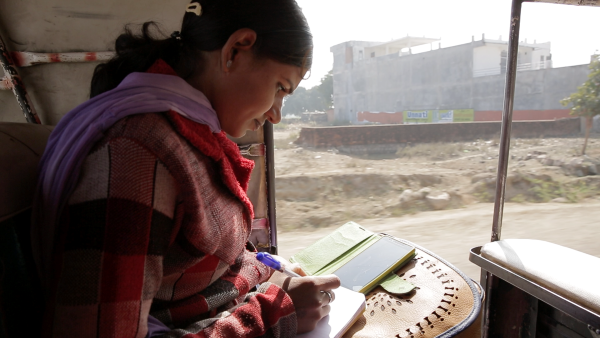![]() This stirring documentary introduces us right away to the plight of India’s Dalits, considered to be “untouchable,” the lowest of the country’s caste system, and their women suffer the worst for it. Early on, a reporter, Meera, interviews a Dalit who has been regularly attacked by a group of men who invade her home and beat and rape her. The police look the other way, or even beat her themselves, because of her caste.
This stirring documentary introduces us right away to the plight of India’s Dalits, considered to be “untouchable,” the lowest of the country’s caste system, and their women suffer the worst for it. Early on, a reporter, Meera, interviews a Dalit who has been regularly attacked by a group of men who invade her home and beat and rape her. The police look the other way, or even beat her themselves, because of her caste.
Luckily, Meera isn’t just any reporter, but a Dalit herself who writes for Khabar Lahariya, a newspaper established in 2002 by Dalit women in the northern province of Uttar Pradesh. As filming kicks off in 2016, a major decision has been made: the news source is switching to digital, which looks to be a considerable challenge as some staff members have never yet held a smartphone. But as senior leadership explains, switching to a website and creating a YouTube channel aren’t just necessary for their survival, but a means of potentially expanding their audience and reach. It’s a worthwhile gamble for Khabar Lahariya; its mission is to empower those at society’s margins.
Directors Sushmit Ghosh and Rintu Thomas follow a cross section of the women who are at different stages professionally and personally. The focus alternates between the stories they’re working on and their struggles resulting from caste status and being a woman working in a male-dominated field in modern-day India. Meera may be a veteran presence in the office whom everyone looks up to, but her home life is another story, in no small part because her husband won’t do housework or participate in child-rearing and makes no secret of how little he thinks of his wife’s career.
The filmmakers seem most fascinated by the disconnect between their protagonists’ gender and origins and their potential. The well-educated Meera, for example, lives in a drab flat amid what appears to be a slum. This dynamic is especially true of forceful fellow journalist Suneeta. She still lives with her parents in a home without electricity and feels the pressure to get married and settle down. (She comes of age on screen in an extraordinary scene at a protest: an all-male group of miners initially won’t talk to her because she supposedly doesn’t know her place, but she gradually wins the crowd over.)
The first half has a generally upbeat tone as the outlet’s online presence starts gaining traction—the filmmakers regularly cut to a counter showing the accelerating growth of views of their YouTube channel. Then comes the second half, in which the major plotline concerns coverage of the 2019 general election. For some of the staff, who have never covered a story of this magnitude before, there is a degree of trial by fire involved, but it’s satisfying seeing them become battle-hardened. Such seasoning also comes in handy post-election as they find themselves interviewing high-profile political figures.
The film touches on the realities of digital journalism, with regular peeks at the comments sections accompanying the reporters’ stories. At first, they are full of compliments and even potential leads, but as the outlet’s profile grows, they become the target of trolling that should be familiar to anyone who’s ever peeked at the comments in any major news site. Along with the requisite accusations of fake news are inflammatory accusations, that these reporters are promiscuous. The film concurrently addresses the increasingly risky climate for Indian journalists, especially for women. Some of the most prominent are targeted for attacks or worse.
None of that deters the main subjects, who by the end have already started changing perceptions of who can hold and wield power in Indian society, paving the way for the film to close on a rousing note. Writing with Fire starts out as an underdog story, but by the end, it’s about a big dog that can hold its own in any fight.

















Leave A Comment